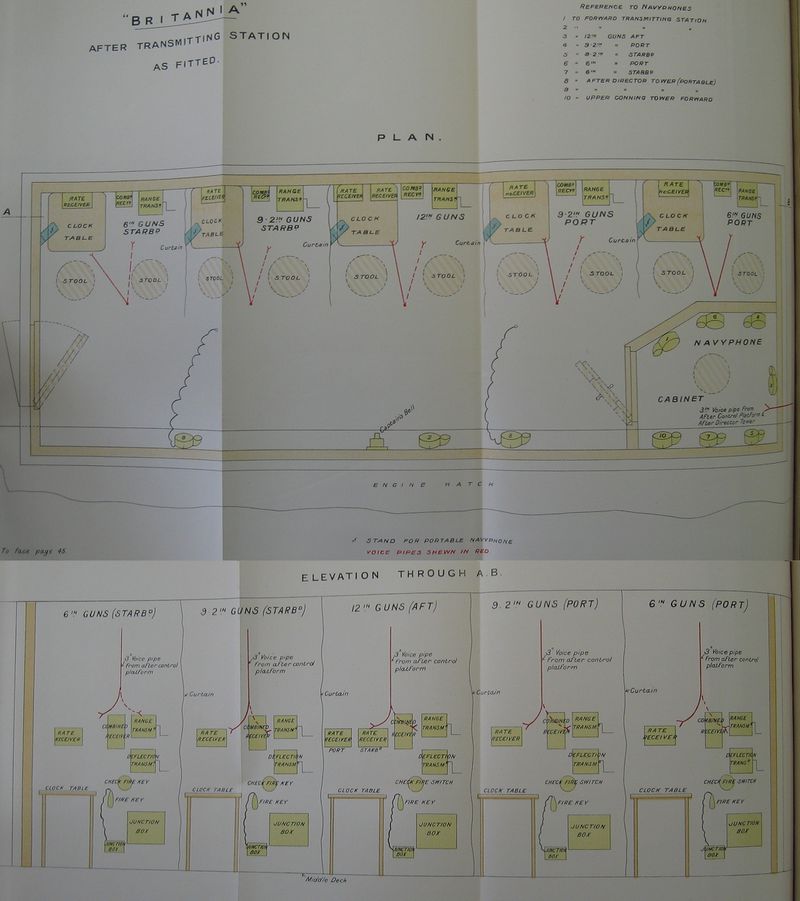Transmitting Station
A Transmitting Station (in Royal Navy parlance) is a room deep within a large ship where calculations pertaining to gunnery are worked and from which orders, ranges and deflections are transmitted to the guns. The function varied by ship, period and navy. Most vitally, the various nationalities had different words for their version of this room:
- British
- "Transmitting Station" or "T.S." (archaic: "Exchange")
- American
- "Plotting Room" or "Plot"
- French
- "Post Central" or "P.C."
- German
- "?" (translated as "Artillery Exchange")
Origins
Prior to 1906, as fire control instruments were being rapidly adopted, the transmitters for range, deflection and order data would be situated at the control positions.[2][3] A test in 1906 in the armoured cruiser Duke of Edinburgh found that there were more advantages than disadvantages to moving the transmitters below:[4]
- (+) The men working the transmitters were protected and not distracted
- (+) The spotters and rate officers aloft not distracted by transmission details
- (+) Voicepipes to T.S. more easily repaired than transmitter wiring from tops
- (+) Easier to switch to secondary control position in event of casualty
- (+) Wiring in the mast was expensive and prone to failure
- (-) Spotting corrections get to guns more slowly
- (-) Practice is required before the arrangement works smoothly
The term transmitting station was coined in 1906 to replace the vague word "exchange" first used after the move below decks.[5]
Capital ships in the Royal Navy tended to have 2 T.S.es fitted (one fore and and aft) prior to King George V and Queen Mary which inaugurated a switch to a single T.S.[6]. At least some ships with 6-in guns in the secondary battery, however, had an additional T.S. to support their fire. Stress was placed on keeping all T.S.es fully manned in action in case the second were needed, and it would be the men in the T.S. who would manage the fallback to a secondary control position in case of a primary one being damaged, but control officers aloft were trusted to hand off control if the target were obscured to them for an extended period.[7]
The size and sophistication of these compartments and their equipment varied by the nationality, date of design and type of vessel; those of the later and larger ships of the most technologically advanced nations boasted the largest dimensions, and were richest in their number of instruments and attendant personnel. Over time, the tasks of calculation and plotting in the T.S. would grow so large that the term's focus on where transmitters are would seem peculiar.
Function in British Capital Ships
A transmitting station was generally understood as the font from which range and deflection and order data emanated for use by the guns, directors and control positions of the ship. To accomplish this task, the T.S. had to be a place
- fed with wiring to receive information
- housing equipment and people within to convert this information into range, deflection and order information
- equipped with cables by which the range, deflection and order information could be sent outward to the guns, directors and control positions that would require it.
Let us for the moment avoid worrying about the second item, as the means by which the continuous range and deflections were generated evolved over time, generally culminating in the use of a Dreyer Fire Control Table whose adornments would themselves be refined over time. Let's examine the T.S. as a black box with a set of inputs and outputs.
Inputs
To calculate ranges and deflections, the T.S. and its crew required information to develop a firing hypothesis, and this mandated that it also serve as the agency to which all
- Range cuts
- Bearing observations
- Spotting reports
- Wind data
- range rates
- visual estimates of enemy speed, heading or inclination
- Own speed and heading data
- angles of elevation and training
- basic gunnery orders
were directed. These arrived over data circuits or verbally by navyphone or voicepipe. Generally, each such report was delivered by protocols or by distinct circuits such that the point of origin was clearly identified.
It was the T.S.'s task to relay some of these to the appropriate audience or to process them by whatever means were en mode before handing on the range and deflection for shooting.
Outputs
No matter the means of calculation, the T.S. was required to
- report a stream of ranges and deflections to be used in firing
- relay or originate and transmit orders for how to carry on
- in director firing, relay angles for elevation and training and firing key impulses, or signal by a gong when to fire
The British appreciated that a ship might be called upon to engage more than one target, and this implied that there had to be more than one channel over which such data could be broadcast. They called each separate group of guns that might be addressed in this manner a control group and accorded each a set of transmitters for range, deflection, and order information.
See Also
Footnotes
- ↑ Fire Control, 1908. Enclosure XV.
- ↑ Annual Report of the Torpedo School, 1904. Plate 40A.
- ↑ Annual Report of the Torpedo School, 1905. Plate XXVIIIA.
- ↑ Annual Report of the Torpedo School, 1906. p. 87.
- ↑ Annual Report of the Torpedo School, 1906. p. 88.
- ↑ Handbook for Fire Control Instruments, 1914. p. 51.
- ↑ Manual of Gunnery, Vol. III', 1915. p. 4.
Bibliography
- H.M.S. Vernon. Annual Report of the Torpedo School, 1905, with Appendix (Wireless Telegraphy). Copy 22 at The National Archives. ADM 189/25.
- H.M.S. Vernon. Annual Report of the Torpedo School, 1906, with Appendix (Wireless Telegraphy). Copy 46 at The National Archives. ADM 189/26.
- Admiralty, Gunnery Branch (1914). Handbook for Fire Control Instruments, 1914. G. 01627/14. C.B. 1030. Copy 1235 at The National Archives. ADM 186/191.
